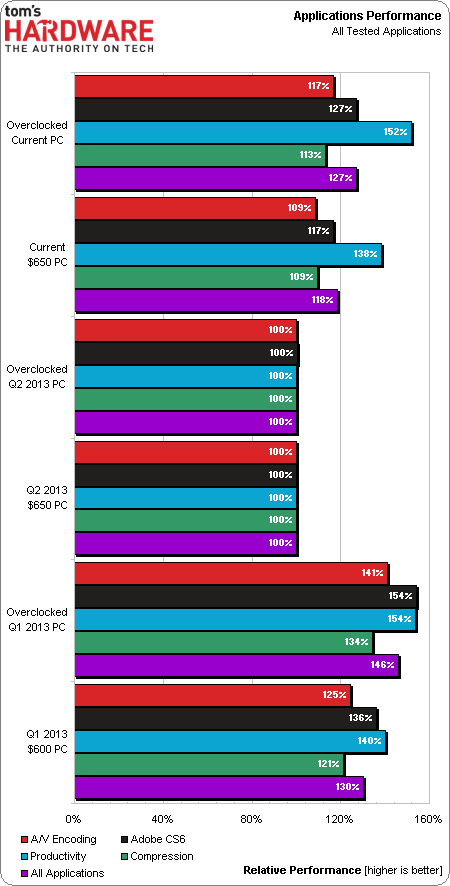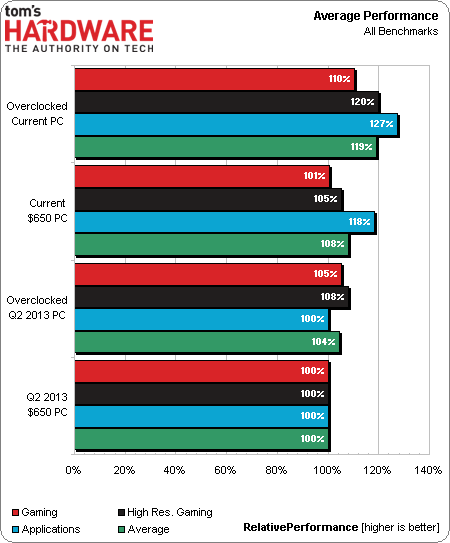System Builder Marathon, Q3 2013: $650 Gaming PC
Bring On The Competition! Is This The Ultimate SBM Gaming PC?
Packing capable $250 graphics cards, our last two gaming-oriented PCs were, above all else, built to play games. The Core i3 processor in last’s quarter’s mighty mini-ITX system breezed through each title we tested, while the overclocked Tahiti-LE based Radeon card chewed through the highest detail settings at 1920x1080. It even proved capable at 4800x900 using lower-quality options. Naturally, that build is a great comparison point for today's effort.
This quarter's machine is a beast right out of the box, boasting a critical edge in graphics prowess and delivering playable frame rates in all four of the games we test at 1920x1080 using the highest detail levels. Overclocked, the beefy GeForce GTX 760 even does well maxing out Battlefield 3 in Surround at 4800x900. It only falls short at the same resolution in Far Cry 3, a demanding game that typically requires one of our higher-budget builds anyway. At $650, we set our sights on 1920x1080, and the GeForce GTX 760 is plenty-powerful for that goal.
It was a forgone conclusion that our graphics card choice was faster than what we've picked before. More interesting is the comparison between AMD's FX-6300 and last quarter's Core i3. See, I confidently placed huge expectations on the $120 six-core CPU, tentatively billing it as the ultimate value-oriented option for our System Builder Marathon. We couldn’t use one last quarter because there aren't any mini-ITX motherboards to accommodate the hot little chip. If there were, we still would have recommended a more efficient Core i3 or i5. So, this quarter was the first time in a while that I could tackle the entire test suite without a higher budget or cutting spending on graphics. What was the overall outcome?
Well enough that I didn't think the story was complete after comparing today's configuration to the previous build. Instead, I revamped our charts and analysis to include the first quarter's $600 gaming PC as well, which targeted all-around performance using Intel’s Core i5 and a Z75 PCH. As you can see in the chart above, AMD’s FX-6300 is in an entirely different league than Intel's Core i3 in threaded benchmarks, where it trades blows with the more expensive Core i5.
In terms of overall system performance, today's $650 PC easily surpasses last quarter’s machine. And remember, I use calculations heavily weighted toward gaming, while officially this system will be judged more on its ability to work, rather than play. To that, I say bring on the competition!
Then again, the FX-6300's added power consumption outweighs its performance edge, translating to a drop in relative efficiency.
We're not giving you any new information here. We already knew that the FX-6300 is a capable CPU with modest overclocking headroom (providing you can keep it cool). Many readers have been screaming about Vishera's six-core implementation, and for good reason. Without cheating on our budget or stacking the deck, we're confirming that you can build an AMD-based rig that is competitive in games and still dominates the threaded workloads. No, it can't match Intel's pricier Core i5 on a consistent basis. Despite Intel's limits on overclocking, a Core i5-3350P easily outpaces Vishera at 4 GHz. But it also costs more, and I’m confident that FX-6300 gave me the most potency in my budget without giving up high-resolution gaming. And really, that's what my SBM gaming PC is all about.
Intel is currently rolling out its dual-core Pentium and Core i3 models based on the Haswell architecture. Maybe those will be worth looking into. But until we start seeing some affordable enthusiast-oriented parts from that company, my down-low trend for the System Builder Marathon (barring any themes that necessitate low-power) is swaying in AMD’s direction. Maybe next quarter we can fit an eight-core FX into this budget. Or perhaps a cheap Athlon X4 750K would meet our needs. Leave a comment to let me know what direction you'd like to see us go.
Current page: Bring On The Competition! Is This The Ultimate SBM Gaming PC?
Prev Page Gaming Performance SummaryGet Tom's Hardware's best news and in-depth reviews, straight to your inbox.
-
Darkerson Not a bad little entry system. Im sure it will get picked apart here in the comments soon, but for the price, its not that bad at all.Reply -
iam2thecrowe I think this time you chose the perfect balance of cpu and gpu at this price point. The Athlon 750k is far too weak, please don't use it next month, even an fx41xx or 43xx would be a better choice. The Haswell i3 would be interesting as we might be able to get some overclocking wby increasing base clock strap settingsReply -
Onus It looked great until I saw the mobo, then I thought "oops..."Reply
Based on http://www.overclock.net/a/about-vrms-mosfets-motherboard-safety-with-high-tdp-processors and https://spreadsheets.google.com/spreadsheet/pub?key=0AgN1D79Joo7tdE9xMUFlMEVWeFhuckJEVF9aMmtpUFE&gid=0 I would have gone with http://www.newegg.com/Product/Product.aspx?Item=N82E16813138372 instead; it has a heatsink on its VRMs, and it currently offers free shipping and is $2 less (it's been that way for a while now; I've had my eye on it for recommendations). I'm concerned that the cheap MSI will pop in the middle of a long gaming session. Did you by chance point an IR thermometer at its VRMs during your testing?
Otherwise, it's nice to see the FX-6300 get a workout in which it performs in the same ballpark as its competition, maybe a little less "raw," but with higher bang/buck.
-
noob2222 its crazy how fast memory prices change, that kingston kit is now $84 and the team vulcan 2133 and 2400 are <60.Reply -
designasaurus I'd be interested in seeing an FX 8-core more than the FM2 Athlons. In general though, it would be nice to see an AMD processor in these quarterly builds more regularly. I know you guys treat it as a competition, but, for readers like me, it's more informative to see how the competition shapes up rather than seeing 5% boosts from the latest Ivy-to-Haswell iteration. The higher budget guys are pretty much exclusively using Intel these days (I'll get my Haswell comparisons there), so your lower budget builds are the only place to reasonably see how a good AMD build stacks up. FX-6300 is definitely the best value AMD processor though, so it's going to be tough for you to beat this if you go up or down in cpu budget to get the Athlon or octocore.Reply -
m32 I would have to put an fan over the VRMs to feel safe. That is just me. designasaurus, nice read and I agree.Reply -
ingtar33 nice build. though i probably would have went with a 7950, and took the $50 saved to get a cpu cooler like the hyper evo 212, and a better overclocking motherboard like the m5a97 R2.0... you probably would have been able to give that fx a bit better of a chance to hit mid to high 4s on the overclock then. if you can get a 6300 up around 4.7-4.9 (obviously not all of them can get there) you can pace an i5 pretty easily... so spending a little on the board and cpu cooler is a good option.Reply
the 8 core 8320 is getting pretty cheap. the problem is in order to unleash that type of power you're probably going to NEED to go with a hefty cpu cooler and hefty overclocking board. so for the future i suggest you keep with the fx 6300 unless the prices on the 8320 come down a little more. -
Lee Yong Quan would love to see how well does the $350 pc compare with the Q2 $400 PC! then i would know how well my pc would perform when gta 5 is out!Reply -
bemused_fred Why is everyone saying "go with the HD 7950" when they clearly said in the article that it only became cheaper after they finished the build?Reply
"AMD's Radeon HD 7950 now sells for even less. But at the time we picked our parts, the GeForce GTX 760 was more affordable."
Honestly, read the article before commenting!



